This month Astrowatch travels to Manchester for the meeting of the
International Astronomical Union. Emma Sanders reports on two
weeks of discussion and discoveries, from the distant universe to new planets
on our doorstep.
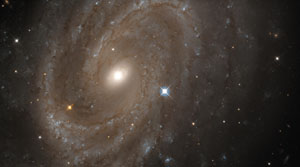
Recent years have seen a transformation of many areas of astronomy. New
instrumentation makes arcsecond resolution almost commonplace across the
whole electromagnetic spectrum, where previously it was the domain of just
radio and optical observations. New satellites have opened up windows on
the universe in wavelengths such as ultraviolet, X-ray and infrared, where
little was previously known. The International Astronomical Union
conference in Manchester underlined the new science that can now be done.
New precision measurements are settling old problems – how galaxies
formed, how the universe will end – and providing new tests for fundamental
physics, such as general relativity and magnetic field
theory.
Cosmological parameters
“We are entering a new era of
precision cosmology,” said Malcolm Longair of Cambridge, kicking off the
session on New Cosmological Data and the Value of Fundamental
Parameters.
His remark provoked a response from Wendy Freedman
of Carnegie Observatories in the conference newsletter. She pointed out the
need to control systematic effects and to target high accuracy as well as
precision. She noted welcome progress with new experiments designed to
reduce the systematic errors that have historically dogged all measurements
of cosmological parameters. “My own definition of precision would be
restricted to measurements at the few percent level, and we are not there
yet,” she said. “However, I believe we have entered the realm where 10%
measurements are possible and factors of two are behind us.”
The
Hubble constant This sector is an excellent example of such new
optimism. Hubble’s law states that the further away a galaxy, the faster it
appears to recede. The constant of proportionality – the Hubble constant –
fixes the age of the universe.
After years of conflict between those
who believed the Hubble constant to be 50 and those who found 100,
different determinations of this fundamental distance measure are now
converging on a value of around 75. Freedman used a new calibration of the
period-luminosity relation for Cepheid variable stars and got a value of 75 ±
10 using data from the Hubble Space Telescope. The big uncertainty now
comes in the local calibration of the Cepheids: if we knew the exact distance
to our nearest neighbour galaxy (the Large Magellanic Cloud), the
uncertainty in the Hubble constant would be less than 5%.
However, a
word of warning came from Tom Shanks of Durham. The method of using
Cepheid variables as standard candles is highly dependent on the composition
of these stars: estimations of distances could be in error by as much as
25%.
The symposium also highlighted recent progress in measuring
the Hubble constant using the Sunyaev Zel’dovich effect. This occurs when
hot gas in clusters of galaxies scatters the cosmic microwave background
(CMB) radiation. Values for the constant of 75 and 65 were reported with
uncertainties of around 15%. The accuracy of this technique will improve as
the resolution of X-ray telescopes increases.
The problem of the oldest
stars appearing older than the universe (the “old wine in new bottles”
dilemma) seems to have been solved following adjustments of the local
distance scale after the Hipparcos mission. Calculations now place the oldest
stars at 11-12 ¥ 109 years old,
consistent with the latest value for the age of the universe.
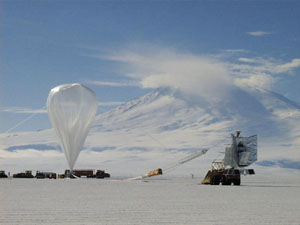
The
microwave background Observations of the CMB are the closest that
astronomers can get to the beginning of the universe. The CMB dates from
300 000 years after the Big Bang, when radiation uncoupled from
matter.
Experimental advances in CMB astronomy mean that
high-resolution maps of the sky are becoming available for the first time. The
conference was excited about results from the Boomerang and Maxima
balloon missions (March p12).
The balloon results have confirmed an
overall picture of a spatially flat universe, where omega = 1 (where omega is the
ratio of matter in the universe to the critical level needed to halt the
universe’s expansion). This is consistent with the inflation model of the Big
Bang.
“The glorious thing is that the peak is right where it should be,”
said Jim Peebles of Princeton, commenting on the CMB angular power
spectrum. The peak shows that the characteristic scale of coherent patches on
the CMB sky is about one degree.
However, there are calibration
problems with the balloon experiments. Paul Richards from California
commented that, to obtain the fit, it was necessary to reduce the values found
by Maxima by one standard deviation (8%) and increase those from
Boomerang by one standard deviation (20%).
The next set of
detectors is not far behind. Three different interferometer arrays will survey
small patches of the CMB: the Cosmic Background Imager, the Degree
Angular Scale Interferometer and the Very Small Array (November 1999
p13). These instruments are best for the detailed study of CMB structure.
Astronomers are eagerly awaiting the next meeting of the American
Association for the Advancement of Science in February 2001, when the
first results are expected.
An accelerating universe Large-scale
structure surveys, such as the Anglo-Australian 2dF and the US Sloan
Survey, are starting to yield their first results, giving a better understanding
of the evolution of large-scale clustering. Astronomers do not observe
enough baryonic or dark matter in the universe to account for an omega value of 1. This has led to a resurrection of the
“cosmological constant” – a kind of vacuum energy density that changes the
acceleration of the universe.
This picture is confirmed by observations
of type 1a supernovae, which have always essentially the same luminosity
and can therefore be used for distance calculations. Observing how their light
is redshifted shows how much the universe has expanded. Saul Perlmutter of
Berkeley told the conference about plans for a space-based supernova
detector called SNAP (SuperNova Acceleration Probe), which would
dramatically increase both the statistics – detecting up to 2000 supernovae
per year – and the redshift of the supernovae observed.
“What’s
amazing now is that different lines of analysis are coming together in a story
that agrees with what theory tied down years ago,” Peebles told CERN
Courier. “This is deeply impressive and has caused me to up my grades,”
he said. “A year ago I was against this convergent model; now, if I were
writing a report card, I’d say: ‘Lambda [cosmological constant] shows great
promise, low mass density – very good, homogeneity – excellent!’ “
In
his summary of the symposium on fundamental cosmological parameters,
Martin Rees of Cambridge brought the meeting back down to the ground.
It’s all very well measuring these parameters with incredible precision, but
maybe what we are observing now is just a special case. Just as the ellipse of
the Earth’s orbit changes each time, are there lots of different versions of
these “fundamental” parameters? He added that, in his view, there were two
types of cosmologists: the theoretical astrophysicists and the mud wrestlers.
He included himself in the latter category.
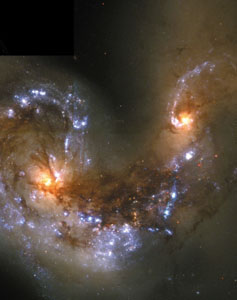
The formation
of galaxies
The optimism from cosmologists was not mirrored in the sessions
on the extragalactic infrared background. “We still don’t have the right story
for how galaxies form,” said Peebles.
Michael Harwit of Cornell set the
meeting some ambitious targets. What were the first galaxies and how did
they evolve? When did stars start to form and how can we explain the
distribution of the heavy elements that we observe today? Our understanding
of the evolution of galaxies and stars is far from complete and observations
are fraught with difficulties. Important clues are certainly to be found in the
cosmic infrared background, first detected in 1996. The infrared emission
comes from light reprocessed by dust.
Reviewing the current state of
affairs, Peebles explained that, looking back to a redshift of 1, galaxy
formation had already finished – galaxies looked as they do today. However,
models of star formation suggest that approximately half of all stars formed
after this time.
Even less well understood is the nature of galaxies
between a redshift of 1 and 2. “Is this the era when galaxies formed?” asked
Peebles, “and if the first galaxies were formed by dark matter halos merging
at high redshift, why don’t we see knots of mass at such distances that would
be evidence of this kind of merger?” Different presentations underlined the
difficulty in estimating star light in real terms – some estimations varied by a
factor of two.
Michael Rowan Robinson from London’s Imperial
College commented that the majority of the mass of the universe is in
low-mass stars that are in low-mass, gas-rich spiral galaxies. High-mass
elliptical galaxies formed during the early part of the universe, then after a
redshift of 1 came the low-mass stars.

Infrared surveys
Catherine Cesarsky, director of the European Southern Observatories (ESO),
spoke of a survey conducted at a 15 mm
wavelength using ISOCAM, the camera on board the Infrared Space
Observatory. A total of 1000 galaxies were observed and the team was
looking for comparisons in the Hubble deep field of distant galaxies. She
found that the galaxies got brighter as their redshift increased. Most were
members of a class of ultraluminous infrared galaxies with a density peak
between redshifts of 0.7 and 0.8. These galaxies have been resolved for the
first time and account for about 50% of the infrared background radiation.
Their study will reveal much about the origins of galaxies that we see
today.
Later, Simon Lilly of Toronto explained how he combined
results from ISOCAM with observations using SCUBA, the infrared camera
on Mt Wilson. This, Cesarsky told CERN Courier, was her highpoint
of the symposium. She was enthusiastic about the possibilities revealed by the
ISOCAM survey, which bode well for similar studies at other infrared
wavelengths. “To understand what is going on we really need to find out
what the infrared sources are. This is what we are now starting to do for the
first time.” Cesarsky is keen to work with ESO’s Very Large Telescope on
the optical identification of ISOCAM sources.
Rees stressed the need
to push the observational boundary even further to improve the study of the
early galaxies. “The Next Generation Space Telescope will be detecting
pregalaxies in the infrared beyond redshifts of 5 – high redshift galaxies are
only 1arcsecond across and very weak, so we need better sensitivity and
resolution,” he said.
NASA’s Space Infrared Telescope Facility
(SIRTF) is scheduled for launch in December 2001 and ESA is preparing the
Far Infrared and Submillimitre Telescope (FIRST), which is due to be
launched in 2007.
The latest advance in instrumentation was a key
theme running through the whole conference. Nowhere was this more
obvious than in the session on galaxies and their constituents at the highest
angular resolutions. This will be covered in part two of the IAU meeting
report in next month’s CERN Courier. Discover the latest
observations of black holes, megamasers and jets, and find out about new
IAU president Franco Pacini’s plans for greater collaboration between
particle physics and astronomy.
Meeting highlights
“For
me the highlight has to be the convergence of different cosmological
parameters: microwave background measurements, supernovae studies,
large-scale structure and gravitational lensing…all the numbers
agree!”
Virginia Trimble, chair of the Division of Astrophysics
of the American Physical Society, works at California, Irvine
“I’m
very excited about the discovery of a planet around Epsilon Eri, because it’s
an old friend – I have studied it in the past.”
Indeed, the discoveries of
no fewer than nine new planets were announced in Manchester. Epsilon
Eriidani is particularly interesting as it has a size and orbit similar to those of
Jupiter and the observations suggest that there may also be an Earth-sized
planet orbiting the central star.
Carole Jordan, University of
Oxford
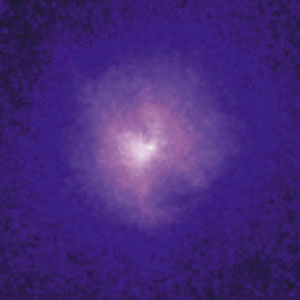
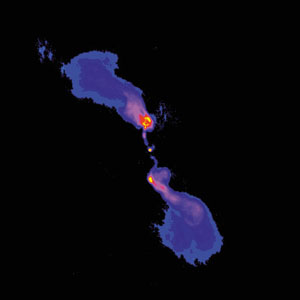
“With the first results from Chandra and XMM, it is the
first time there is comparable resolution between X-ray and radio
observations. One thing I learned this morning was that new X-ray maps of
galaxy clusters show the holes where the hot X-ray emitting gas of 100
million degrees has been blown out by the relativistic plasma in the radio
jets…they match perfectly with the radio images!”
Sir Martin
Rees, Institute of Astronomy in Cambridge







